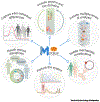A platform to map the mind-mitochondria connection and the hallmarks of psychobiology: the MiSBIE study
- PMID: 39389809
- PMCID: PMC11555495
- DOI: 10.1016/j.tem.2024.08.006
A platform to map the mind-mitochondria connection and the hallmarks of psychobiology: the MiSBIE study
Abstract
Health emerges from coordinated psychobiological processes powered by mitochondrial energy transformation. But how do mitochondria regulate the multisystem responses that shape resilience and disease risk across the lifespan? The Mitochondrial Stress, Brain Imaging, and Epigenetics (MiSBIE) study was established to address this question and determine how mitochondria influence the interconnected neuroendocrine, immune, metabolic, cardiovascular, cognitive, and emotional systems among individuals spanning the spectrum of mitochondrial energy transformation capacity, including participants with rare mitochondrial DNA (mtDNA) lesions causing mitochondrial diseases (MitoDs). This interdisciplinary effort is expected to generate new insights into the pathophysiology of MitoDs, provide a foundation to develop novel biomarkers of human health, and integrate our fragmented knowledge of bioenergetic, brain-body, and mind-mitochondria processes relevant to medicine and public health.
Keywords: allostasis; metabolism; mitochondrial disorders; mtDNA; psychobiology; stress.
Copyright © 2024 The Authors. Published by Elsevier Ltd.. All rights reserved.
Conflict of interest statement
Declaration of interests The authors have no competing interests to declare.
Figures





References
-
- Langer EJ (2023) The mindful body, thinking our way to chronic health, Ballantine
-
- Damasio A (2018) The strange order of things: life, feeling and the making of cultures, Vintage
-
- Sterling P (2020) What is health? Allostasis and the evolution of human design, MIT Press - PubMed
-
- O’Connor DB et al. (2021) Stress and health: a review of psychobiological processes. Annu. Rev. Psychol. 72, 663–688 - PubMed

